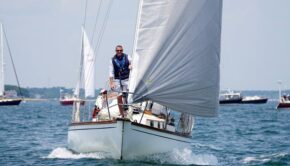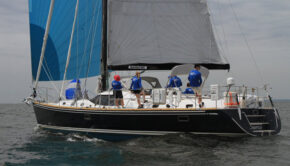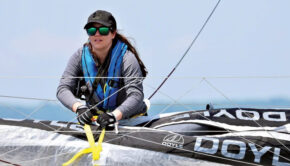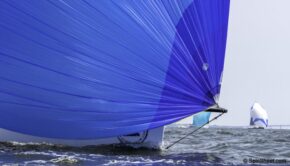AIS Regulations for Offshore Racing
Published on August 14th, 2017
by Jim Praley
Any sailor who uses AIS (Automatic Identification System) quickly comes to appreciate the safety advantages the system provides, allowing a boat to “see” traffic, whether commercial shipping or recreational crafts, at a significant distance, and to determine that traffic’s course, speed and closest point of approach.
Over the last several years offshore race safety regulations have evolved from recommending the use of an AIS receiver to requiring that in most races competing boats have an AIS transponder (receiver and transmitter) installed.
The World Sailing Offshore Special Regulations (OSR) expressly require the use of an AIS transponder on boats competing in Category 1, 2 and 3 races, and the US Sailing Safety Equipment Requirements (USSER) similarly mandate AIS transponders on races classified as Offshore.
The two sets of regulations are very specific about the equipment installation, requiring a transponder (not just a receiver) which either shares a masthead VHF antenna by way of a low loss antenna splitter, or uses a dedicated VHF antenna, at least 3 meters over the water and fed with coax having a maximum 40% power loss.
What the regulations don’t address is whether the AIS has to be turned on.
Almost all AIS transponders have a ‘stealth’ switch, allowing the unit’s transmitter function to be turned off while continuing to receive other boats’ positions and display them on a chart plotter or laptop.
This summer I sailed in two offshore races – the 474 nm Annapolis to Newport Race in early June and, in July, the 363 nm Marblehead to Halifax Race – and the two events handled the issue differently.
Annapolis to Newport didn’t specifically address AIS installation or use in either the Notice of Race or the Sailing Instructions, simply requiring that all competitors be in compliance with the USSER which contain the AIS requirement. I confess to having a hand in this since I chaired the event Organizing Committee.
Our reasoning was that by adopting the USSER by reference sailors wouldn’t have to flip back and forth between the NOR and the regulations to determine the race equipment requirements. At the end of the day, however, we never dictated to competitors as to whether or when the AIS was required to be transmitting.
The Halifax Race, on the other hand, put the transponder requirement right up front in the NOR, even marking it in red type as a significant change from prior years. More significantly, the SIs required that:
“Each boat shall start transmitting her position using her Automatic Identification System (AIS) beginning no later than 2000 ADT on the day of the start and ending no earlier than after she has entered the Northwest Arm in Halifax.”
So was there a difference in the race experience? In a word, yes.
In the Newport Race a significant number of our competitors chose to go to stealth mode shortly after the start, sometimes going ‘live’ in high traffic areas where they definitely wanted to be noticed by the fishing fleet or ships running commercial traffic lanes at speed. This left us to guess our position relative to our competition.
By contrast, in the Halifax Race only a few of our class competitors ever dropped off the screen, probably due to the distances between us, and we were able to keep track of pretty much everyone’s position and speed – we even set up a rudimentary spreadsheet to keep track of relative bearings gleaned from AIS to gauge our progress.
That tracking paid off in the middle of the night off the Nova Scotia coast when our sharp-eyed and likely over-caffeinated watch captain Brian Flynn checked the navigation laptop and noticed that several boats ahead of us had dramatically dropped speed, leading us to deduce that there was a hole in the breeze and head further east for an end-around move, likely improving our finish by several places and resulting in a podium finish.
(To be fair, in both races we carried Yellow Brick trackers which can’t be turned off, but Yellow Brick position reports aren’t always real time and once we were out of cell phone range of land accessing the leaderboard via the limited bandwith of a Satphone became nearly impossible.)
The question then is: since AIS transponders are required by the applicable safety regulations, should boats be required to transmit throughout the race or should they have the option of running silent for tactical reasons?
One obvious argument against mandating transmission is that real time tracking can lead to a sheep mentality, with everyone following the leader. For my part, I like playing the chess board, knowing where my competition is and trying to find another way to go that might be faster, so mandatory transmitting is fine.
A lot of the safety advantages for which AIS was required in the first place go away when you don’t turn it on and the other boat can’t see you. It will be interesting to see how this plays out.









 We’ll keep your information safe.
We’ll keep your information safe.